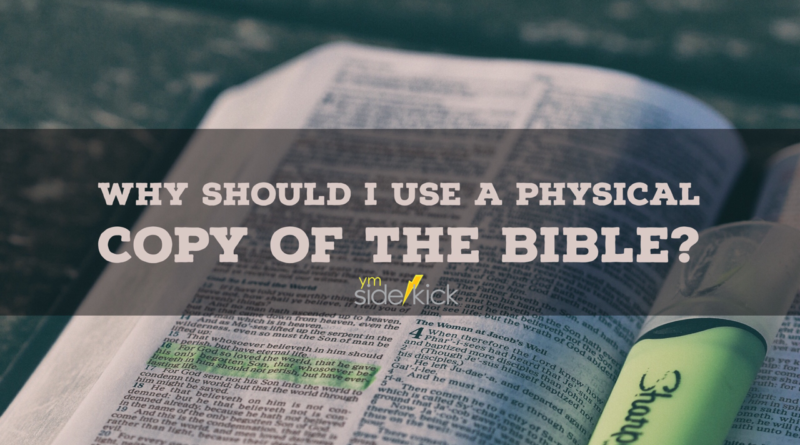Why should I use a physical copy of the Bible?
I wrote an earlier post about why to use the YouVersion Bible App (or other Bible app) for the purpose of discipleship, but prefaced that post with the truth that we use a physical copy of the Bible as often as we can.
During our Sunday morning or Sunday evening youth programs, we pass out physical copies of the Bible and encourage students to follow along and read, not on their phone or device, but in the hard copy.
If I believe so strongly that we should use the YouVersion Bible App, and promote it in our ministry, why would we also emphasize using the physical copy of the Bible?
There are a multitude of reasons, but I believe some of the most important are these:
First, user-friendly nature of the physical copy
A physical copy of the Bible, and really any book, is easy to use. We can open it, flip through it, jump around, hold our finger in multiple places at once, etc. It is very user-friendly.
I prefer the physical copy of the Bible because I can underline, highlight, and make notes in the margins. I can do similar things with the app, but in a physical copy I can see all of these notes and underlines without having to click extra buttons or remember how to access the notes, etc. It truly is easier all-around to use.
There’s a famous quote attributed to Charles Spurgeon that says, “A Bible that’s falling apart usually belongs to someone who isn’t.” I don’t quite know how that quote could be adapted to the Bible app. I think there is a lasting truth to the fact that a physical Bible that is falling apart belongs to someone who isn’t.
Second, larger narrative and context of Scripture
When using the Bible app it can be harder to realize the interconnectedness of Scripture. Seeing just one chapter or book at a time causes us to lose the greater context and narrative of Scripture.
This is not just a compilation of 66 books, but is one story with a common thread, tied together in the Person and work of Jesus Christ. Using a physical Bible helps us to see how one story and one book and one chapter connects with the all of Scripture.
Third, less distracting
If I try to read the Bible app on my phone, I’m constantly getting distracted with notifications from Facebook, Gmail, FitBit, Messages, and other apps. I realize part of this is my own fault, having notifications turned on, but these distractions are a reality we and our students will face.
There’s nothing else popping up when we read the physical copy of the Bible. That’s all there is. No new emails or notifications are happening (provided our phone is not next to us, or at least turned over when we’re engaging in the physical copy!).
We are able to spend time reading, re-reading, highlighting and underlining, journaling, and more when we read the Bible in a physical form. There are few distractions to take away from what God is trying to communicate to us through His Word.
Fourth, unlimited battery life
Okay, so this one is a little bit of a joke, but the reality is you don’t need to plug a real Bible in. It has no battery life.
You can flip through it endlessly, writing in the margin, taking notes, highlighting, and underlining to your heart’s content.
No backlit screen is going to hurt your eyes; no ‘low battery’ alert is going to pop up when you’re at 20%. You don’t have to bring cords and find plugs in order to read your Bible. It’s always accessible.
These are just a few reasons why a physical copy of the Bible is preferable to the app. What would you add? Which medium of the Bible do you use most?
 This is a GUEST POST from Ben Marshall. Ben has served as a Youth and Young Adult Pastor in Holland, MI since 2014 and recently became a Campus Pastor in the Fall of 2016. He has a passion for discipling youth and young adults, helping them realize their God-given potential and developing next generation leaders. Ben is married to Connie and their had their first child, Aliya Joy, in October, 2016. Ben’s hobbies include blogging, playing guitar, soccer, and football. Follow him on Twitter or on his blog.
This is a GUEST POST from Ben Marshall. Ben has served as a Youth and Young Adult Pastor in Holland, MI since 2014 and recently became a Campus Pastor in the Fall of 2016. He has a passion for discipling youth and young adults, helping them realize their God-given potential and developing next generation leaders. Ben is married to Connie and their had their first child, Aliya Joy, in October, 2016. Ben’s hobbies include blogging, playing guitar, soccer, and football. Follow him on Twitter or on his blog.
